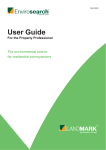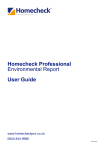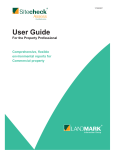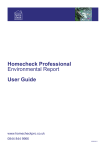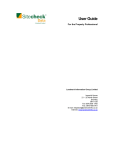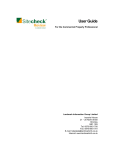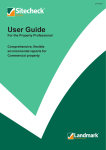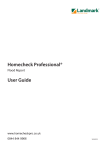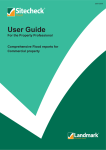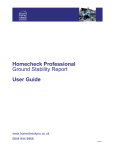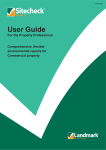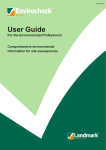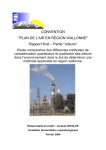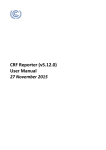Download Homecheck Professional Contamination Report User Guide
Transcript
Homecheck Professional Contamination Report User Guide www.homecheckpro.co.uk 0844 844 9966 20/06/07 User Guide Table of Contents Introduction - About this Guide 3 Why should I get a Homecheck Professional Contamination Report? 3 When should I get a Homecheck Professional Contamination Report? 4 How do I get a Homecheck Professional Contamination Report? 5 What is my Homecheck Professional Contamination Report telling me? 6 How do I proceed now? 8 Appendix Appendix 1: Specific issues in relation to the report Appendix 11 Appendix 2: Potentially Contaminative Past Industrial Land Use Categories 19 Appendix 3: Data sets used in the Homecheck Professional Contamination Report 21 2 1. Introduction – about this Guide 1.1 This Guide has been prepared by Landmark Information Group to assist busy conveyancing practitioners to decide: Whether to obtain a Homecheck Professional Contamination Report on behalf of their clients. What that search reveals. What steps they should take next, in the best interests of their clients. 1.2 The Guide is not intended to usurp the role of the professional advisor, who is uniquely placed to view the whole transaction in consultation with the client, but it is intended to inform that discussion and provide guidance to the advisor in that situation on how to progress the matter speedily, efficiently and cost-effectively. 1.3 It is intended that this Guide is regularly updated to keep pace with the rapid changes to the conveyancing process and to reflect the role which accurate and dependable environmental information plays in that process. Copies of this Guide are available free of charge from www.homecheckpro.co.uk. Alternatively call the Homecheck Professional Contamination Report helpline on 0844 844 9966 or email helpdesk@landmarkinfo.co.uk. 1.4 For further information on any of the topics raised in this Guide the practitioner is referred to any of the available textbooks on the subject, such as: The Law Society’s Conveyancing Handbook, Law Society Publications. The Law Society’s Environmental Law Handbook, Law Society Publications. Environmental Law in Property Transactions, Butterworths. Guide to Contaminated Land, Blackstones. 2. Why should I get a Homecheck Professional Contamination Report? 2.1 A commonly held misconception is that conveyancing transactions have been carried out for decades without any serious environmental problems arising. Practitioners now need to be concerned about the environmental issues underpinning a property purchase. 2.2 There have been a number of instances where serious problems have arisen and it will have been apparent to most practitioners, at least since the introduction in 2000/2001 of the Contaminated Land regime in Part IIA of the Environmental Protection Act 1990, that there are environmental issues in mainland Great Britain that have been largely ignored until now, but which present real risks to purchasers of the affected property. 2.3 In the light of growing public concern about such issues, the Law Society, on 13 June 2001, published in the Law Society’s Gazette and distributed to the legal profession generally, a Guidance Note on contamination issues in property transactions. This Guidance points out the risks referred to in this Guide and offers some suggestions to practitioners as to how they may go about serving theclient’s needs in this area, and lessening the risk of being found negligent. 3 2.4 Whilst contaminated land is perhaps the most obvious risk to contemplate, it is by no means the only one. For example, if contaminants are present, but the land is not “contaminated” within the technical meaning of the word, enjoyment, saleability and value can still be affected. There may be significant restrictions on the usability of the property. 2.5 The main risks are that: A financial liability to clean up the polluted site may fall upon the current owner of the land. The property itself may be, hazardous to health, dangerous or otherwise uninhabitable. The value and/or the use of the property may be adversely affected by some problem. 2.6 Whilst it is by no means yet settled that it would be negligent of a professional advisor to fail to mention these risks to a conveyancing client, the issues have been aired by professional journals, publications, press, media coverage and public debate for several years now. There is such a clear body of collective wisdom available on the subject, and public awareness of the issues, that a Court may now take the view that such issues should be raised by professional advisors as a matter of course, even in routine transactions. 2.7 In the view of the buying public, it is the solicitor, licensed conveyancer or the co-ordinator of the transaction who is expected to raise and deal with these issues, rather than the surveyor, estate agent or mortgage lender. However, in dealing with the issues, the practitioner is able to draw on the expertise of an Environmental Consultant who is uniquely qualified to comment on environmental risk. Should independent full site investigations then need to be made the practitioner is able to engage the services of a suitably qualified professional. 2.8 Step 4 of the Law Society Guidance advises independent site history investigations by obtaining a site report from a commercial company. Obtaining a Homecheck Professional Contamination Report will give the practitioner as much information as is currently economically available, in an accurate and dependable form, on which to base the discussions and advice to their client. 2.9 Furthermore, the Homecheck Professional Contamination Report removes the burden of interpretation of the information disclosed in respect of contaminated land by incorporating an indicative assessment of the potential environmental risk. 3. When should I get a Homecheck Professional Contamination Report? 3.1 A Homecheck Professional Contamination Report should be obtained in connection with any dealing or valuation to do with domestic property, including purchase, mortgage, or further advance, or before any domestic building work, such as self-build or an extension, is undertaken. The report should be obtained before exchange of contracts or any other form of binding obligation. 3.2 The Homecheck Professional Contamination Report is intended for individual domestic properties only. If significant development of the property is intended, or if the practitioner is acting in a commercial transaction, a more detailed site specific search can be obtained from Sitescope, or from Sitescope’s resellers or agents. 4 3.3 A Homecheck Professional Contamination Report is suitable where only a specific contamination check is required, and not a full environmental report. This report will not cover issues other than those relating to contaminated land. For a report that includes information on Radon, Subsidence and Flood you should purchase a Homecheck Professional Environmental Report. 4. How do I get a Homecheck Professional Contamination Report? 4.1 A Homecheck Professional Contamination Report can be ordered by using one of our order forms or alterntively via our website at www.homecheckpro.co.uk. To obtain an order form or register for an account to order online please contact: Landmark Information Group Limited Legal & Financial The Smith Centre Fairmile Henley-on-Thames RG9 6AB Telephone: Fax: DX: E-mail: Internet: 0844 844 9966 0844 844 9980 154400 Henley-on-Thames 2 helpdesk@landmarkinfo.co.uk www.homecheckpro.co.uk 4.2 A separate search should be made for each individual property having a different postal address. 4.3 Order forms should be completed by including: The full postal address and postcode of the property. The name and Document Exchange (DX) number (if applicable) of the practitioner. The practitioner’s file reference and telephone number. A plan of the property (see paragraph 4.4 below). 4.4 If you are using an order form it is requested that a plan showing the location of the property is enclosed with your order. If a plan is not supplied there may be difficulties in identifying the location of the property and this may introduce a delay. 4.5 In normal circumstances a Homecheck Professional Contamination Report will be despatched to the practitioner within 24 to 48 hours of the receipt of the order. 4.6 The Homecheck Professional Contamination Report is also available electronically, normally within 24 hours. 5 5. What is my Homecheck Professional Contamination Report telling me? 5.1 The report will include information from a number of statutory and non-statutory sources, and site history as determined by an analysis of historical Ordnance Survey maps dating from the 1850's. The report provides an overall assessment on the likelihood of the property being described as "contaminated land" as defined by section 78(A)2 of part IIA of the Environmental Protection Act 1990. The report also gives contact details of the organisations where further information may be obtained. 5.2 Sitescope has agreements for the supply or collection of data with a number of national data providers. Notably, Sitescope is a Licensed Partner of Ordnance Survey and a Value Added Reseller for the Environment Agency and the British Geological Survey. The currency of the datasets used is determined by the frequency of updates by the data providers under their respective agreements with Sitescope. 5.3 Any person relying on a Homecheck Professional Contamination Report must comply with the attached Terms and Conditions. 5.4 The replies in the Homecheck Professional Contamination Report will be given in the belief that they accord with the data sets and update cycles listed in Appendix 3, but on the understanding that Sitescope is not legally responsible for them except as detailed in the Terms and Conditions, which may vary from time to time. 5.5 Sitescope is constantly working with data providers to improve the data sets and the information available to Sitescope may change. Accordingly, there is no protection period relating to a Homecheck Professional Contamination Report and practitioners should not attempt to rely on a previous report. Practitioners who rely on a previous report will not have the benefit of Sitescope’s Professional Indemnity Insurance cover. 5.6 Practitioners should note that addresses may have been compared to the Royal Mail Postal Address File standard and therefore may have been changed to comply with this standard. 5.7 The report is split into a summary section, which gives basic information in an easy to understand question and answer format, and an additional information section which gives further details if records are revealed. 5.8 The practitioner should normally be able to easily verify that the report has been correctly located on the subject property using the Site Location map. In the event of any doubt as to the correct location the practitioner should raise this immediately with the agent. Enquiries and Replies 5.9 The Homecheck Professional Contamination Report uses the boundary of the property as the basis of the search if this is digitised. Alternatively, the search can be ordered as a point location and our system will construct a 25m radius circle around this point which will be used as the property boundary for the purposes of the report. Please note that use of the 25m circle is not an attempt to make an approximation of the property boundary. 6 5.10 The Homecheck Professional Contamination Report will be based on the information listed in Appendix 3 to this Guide. The practitioners’ attention is drawn to the update cycles for this information. 5.11 Section A of the report contains Enquiries of Statutory Registers. The enquiries relate to land within 0 - 250 metres from the property boundary. Each different heading contains a location map in the Additional Information section, if records are revealed. These answers are drawn from the statutory registers held by the Environment Agency, the Health and Safety Executive (HSE), the British Geological Survey (BGS) and Local Authorities using the following records: Registered Landfill sites (the Environment Agency). Recorded Landfill sites prior to 1974 (BGS). Licensed Waste Management Facilities (Landfill) ( the Environment Agency). Local Authority Recorded Landfill Sites prior to 1974 (the relevant local authority). Registered Waste transfer, treatment or disposal sites (the Environment Agency). Licensed Discharges to Controlled Waters (the Environment Agency). Registered or authorised keeping or disposal of radioactive substances (the Environment Agency). Licensed industrial processes or discharges (the Environment Agency). Sites permitted to release discharges into the air (Local Authority, the Environment Agency). Sites authorised or subject to regulations concerning the keeping or handling of hazardous substances, explosives, dangerous substances, and sites constituting a major accident hazard (Local Authority and HSE). Records of any enforcements, prohibitions, or prosecutions relating to contamination prosecutions relating to licensed processes or planning hazardous substances (Local Authority, the Environment Agency). Contaminated Land Register Entries and Notices [Part IIa sites] (Local Authority, the Environment Agency). 5.12 Section B of the Report contains Enquiries Concerning Site History, and applies to land within 0 - 250 metres from the property boundary. The enquiries relate to the following: Potentially contaminative industrial sites identified from current published trade directories. Potentially contaminative industrial sites identified from analysis of 1:10,560 scale and selected 1:10,000 scale historical Ordnance Survey maps. Areas of potentially infilled land identified from analysis of 1:10,560 scale and selected 1:10,000 scale historical Ordnance Survey maps. Historical Tanks and Energy Facilities identified from analysis of 1:2,500 scale and 1:1,250 scale historical Ordnance Survey maps covering a period from 1943-1996. This data only relates to land within 0 - 100 metres from the digitised property boundary. 7 The information provided in section B of the report relates to categories of potentially contaminative land uses that have been identified by the analysis of selected Ordnance Survey historical mapping. 6. How do I proceed now? 6.1 The Homecheck Professional Contamination Report constitutes what is known as a “desk-study”, occasionally known as a “screening report”, which is an information gathering source. The information revealed in the search report is a starting point for further investigation. It cannot give definitive answers to what problems actually affect individual properties. Specifically in relation to the risk of contaminated land, every Homecheck Professional Contamination Report provides an overall assessment, based on the data within the report, on the likelihood of the property being described as "contaminated land" as defined by section 78(A)2 of part IIA of the Environmental Protection Act 1990, to assist the practitioner in this decision making process. 6.2 In accordance with the Law Society Guidance, the practitioner will now need to discuss the implications of the information provided with the client and others involved in the purchase transaction, including lenders and other professionals, to decide how best to proceed. 6.3 Essentially, the Report will show either: No identifiable problem. Entries in relation to which further investigation may be necessary. Entries in relation to which further investigation is strongly recommended. 6.4 In many cases the search will reveal no entries of any concern whatsoever and the practitioner can advise the client to proceed, safe in the knowledge that the information is as accurate and reliable as modern mapping and information techniques can make it. Keeping the search with the file or deeds will assist if future reference needs to be made in relation to the information disclosed. In these circumstances, Council of Mortgage Lenders’ advice would be that it is not necessary to alert the lender to the existence or contents of the report. Such a report would receive a "Passed" assessment indicating that it is considered unlikely that the property would be determined to be "contaminated land" within the meaning of Part IIA of the Environmental Protection Act 1990. It is important to note that this assessment is based solely on the information contained and analysed within the Homecheck Professional Contamination Report . 6.5 In some cases the search will reveal entries that may be of some concern, however these entries may not be conclusive such as landfill buffers, where the exact location is uncertain, or the exact nature of the potential environmental risk is unknown, such as a factory or works whose use is not specified. Such a report would receive a "Passed with conditions" assessment indicating that, whilst it is considered unlikely that the property would be determined to be "contaminated land" within the meaning of Part IIA of the Environmental Protection Act 1990, it is suggested that the potential risks outlined are considered before proceeding with the transaction. Page two of the report will list the features of concern together with a suggestion of the next steps that could be taken to gather further information . 8 6.6 Certain features always carry an inherent degree of risk with them and certain types of land-use have particular contaminating characteristics. For example landfill sites may give rise to methane gas generation, old gasworks may have contaminated the land with tars and other chemicals and petrol stations may have leaking underground storage tanks. The nearer to the site the identified entry, then the greater the risk that some problem may occur on the site in question. A report revealing such features would receive a "Further investigation recommended" assessment indicating that it is considered possible that the property would be determined to be "contaminated land" within the meaning of Part IIA of the Environmental Protection Act 1990 and it is strongly recommended that the potential risks outlined are investigated further before proceeding with the transaction. 6.7 It is important to appreciate that where a report has not been passed it does not necessarily mean that there is a problem with the land, merely that there may be, and this possibility may require further investigation. The practitioner or client may undertake this further investigation themselves or alternatively engage the services of a suitably qualified professional. 6.8 The decision whether to proceed, undertake further investigations or withdraw must be the client’s, and it will frequently depend on factors unrelated to the environmental information revealed by the search. Factors such as the cost of the further investigations, the difficulty or delay involved in undertaking them, the accuracy and helpfulness of the further information revealed, the general time scale of the transaction and the client’s attitude to risk will all influence the decision. 6.9 Often, the next step after obtaining a Homecheck Professional Contamination Report is simply to acquire further information (especially as it is usually easily obtainable from an obvious source), rather than to consider a site inspection at additional cost. 6.10 Obvious next steps could be: In relation to further information contact the relevant agency or local authority using the Contacts section of the report. The local authority may have inspected the revealed matter as part of its duties under Part IIA of the Environmental Protection Act 1990. It may also have records of the steps taken by a developer to make the land safe, which would avoid in most cases the need for a site investigation. Contamination concerns, contact an environmental consultant. Valuation concerns, contact a suitably qualified specialist surveyor or valuer. Negotiating appropriate price adjustments, in addition to, or instead of, the above. It cannot be over-emphasised that until the actual extent of a potential problem is investigated and revealed, a practitioner cannot fully advise on its implications, and the Homecheck Professional Contamination Report is only designed to provide the information to enable practitioners to identify the next questions. Equally, the perception of risk is almost invariably worse than the reality, so a practitioner may feel that in the majority of cases the client would be safe in proceeding without further investigation; on the other hand an investigation may put the client’s mind at rest. 9 6.11 Practitioners should develop a range of professional contacts to call on quickly should the client wish to proceed with further investigations. Not knowing where to turn for assistance would cause delay. 6.12 If the subject property is to be charged as security for a loan, the lender should be contacted in any case where entries are revealed. Practitioners should inform the lender what further steps are being taken by the borrower and ask the lender what, if any, further enquiries the lender requires. 6.13 The report should be kept with the title deeds, along with other important documentation. 10 Appendix 1: Specific issues in relation to the report Section A - Enquiries of Statutory Registers A.1.1 and A.1.2 - Landfill The landfill information in the Homecheck Professional Environmental Report comes from four sources: - Records collated by Landmark sourced from individual Local Authorities that were able to provide information on sites operating prior to the Control of Pollution Act 1974 (COPA). Landfill is shown as both points and boundaries. - Sitescope’s own database containing over 13,000 open or closed landfill sites collected from the public registers. Landfill is shown as both points and boundaries. - Records from the British Geological Survey showing over 3,000 old landfill sites which were operating at the time of the Control of Pollution Act 1974 (COPA), and would therefore not have been subject to any strict regulation or monitoring. Landfill is shown as both points and boundaries. - Latest information from the Environment Agency showing the boundaries or point locations of over 2,500 current licensed landfill sites in England and Wales. General Information Landfill is well established as the main disposal method for Great Britain’s waste. Up to 90% of all domestic waste takes this route and it is estimated that there are currently over 13,000 landfill sites in Great Britain. There are three main categories of landfill sites; those accepting domestic, industrial and commercial wastes, those accepting hazardous waste and those accepting inert waste for example, brick, rubble or soil. All three present a potential risk to residential properties. The main risk presented by landfills is from the methane gas created by the microbiological decomposition of biodegradable materials. Methane gas is highly flammable and can become explosive if it accumulates in a confined space. Other landfill emissions also include traces of heavy metals and complex organic compounds such as dioxins. There is concern that people living near certain landfill sites could be at risk from serious illnesses such as cancer and DEFRA are conducting a study to determine the health risks associated with landfill sites. The practitioner should be aware that landfill could affect the homeowner in six ways: - Presence of harmful substances. - Combustibility of materials used to fill the landfill. - Chemical attack on building materials. - Emission of flammable, toxic, asphyxiant or corrosive gases. - Problems with ground stability. - Problems associated with odour and water drainage. 11 If a landfill site is identified the report will disclose the licence details. For further information on a particular site please contact the relevant environment agency or local authority referenced in the Useful Contacts section of the report. Specific Information Section A.1.1. Local Authority Landfill Sites The records in this section have been collated by Landmark and are sourced from individual Local Authorities that were able to provide information on sites operating prior to the Control of Pollution Act 1974 (COPA). On the section map these records are shown as a red square or a red hatched polygon. Appropriate authorities are listed in the report summary with an indication of whether or not they were able to make landfill data available. Details of any records identified are disclosed under the additional information. You should note the following: a) If the response in the summary advises that the local authority ‘Had landfill data but passed it to the relevant environment agency’ it does not necessarily mean that landfill data from this local authority will be included in section A.1.2 of the report. b) If no data has been made available, for all or part of the search area, you should be aware that a negative response in section A.1.1. does not necessarily confirm that no local authority landfills exist. Section A.1.2. Landfill Sites The records in this section are obtained from three separate data sets: - Sitescope’s own database containing over 13,000 open or closed landfill sites collected from the public registers. In the case of this data set, where no boundary is available, approximate positions of the sites have been supplied using a grid reference point. At present no complete national data set exists for landfill site boundaries, therefore, a point grid reference, provided by the data supplier, is used for some landfill sites. In certain cases the point grid references supplied provides only an approximate position, and can vary from the site entrance to the centre of the site. Where the exact position of the site is unclear, Sitescope construct either a 100 metre or 250 metre “buffer” around the point to warn of the possible presence of landfill. The size of this ‘buffer’ relates to the positional accuracy that can be attributed to the point grid reference of the site. On the section map, registered landfills are shown as a green square or a green hatched polygon."Buffers" are shown as a blue hatched circle. - Records from the British Geological Survey showing over 3,000 old landfill sites which were operating at the time of the Control of Pollution Act (COPA) 1974, and would therefore not have been subject to any strict regulation or monitoring. Most BGS landfill sites have boundaries which are shown as an orange hatched polygon on the section map. Where no boundary is available these sites are shown as an orange 12 - Latest information from the Environment Agency showing the boundaries or point locations of over 2,500 current licensed landfill sites in England and Wales. Records of licensed waste management facilities (landfill) cover consents issued for active landfill sites by the Environment Agency under Section 64 of the Environmental Protection Act 1990 (Part II) and prescribed by Regulation 10 of SI No.1056 of the Waste Management Licensing Regulations 1994. These landfill sites are shown on the section map as either a red hatched polygon or a red circle. Where a landfill site is duplicated in one or more of these datasets a "buffer," landfill boundary or point location for the same site may not be coincidental on the section map. A.2 and A.3 - Waste Transfer, Treatment or Disposal In addition to landfill two other types of waste disposal facility that practitioners should pay particular attention to are metal recycling sites and incinerators. These sites can be significant, particularly if they have handled radioactive and toxic wastes. Incinerators may affect surrounding air quality through release of emissions from the chimney, and once closed, incinerators have specific contaminants such as ash and waste water, which should be properly removed or rendered harmless. Waste transfer and treatment stations, although usually posing a lower risk than landfills, incinerators or metal recycling sites, can also be significant. The level of risk to the homeowner will usually depend on how well the site is/was managed but there is increasing concern that waste storage sites may pose a health hazard to those living near them. The practitioner should be aware of the following risks associated with waste processes: - Spillage of ‘difficult waste’ on site such as petrol, oil and paint. - Build-up of some wastes in drains. - Chemicals being washed off site by rainwater and affecting surrounding land. - Noise and dust. If a licence for a waste transfer, treatment or disposal site has been identified the Report will disclose the licence details. For further information on a particular site please contact the relevant agency referenced in the Contacts section of the report. A.4 - Integrated Pollution Control (IPC) Regulations There are thousands of industrial processes in Britain with permits to release pollutants to the air, ground and water. Around 2,000 factory sites can be categorised as major industrial processes, such as power stations, incinerators, chemical manufacturers and cement producers while some 12,000 can be classified as smaller industrial processes. Many sites releasing discharges are maintained under the concept of Integrated Pollution Prevention and Control. Discharges from these sites can be to air, land or water and include gases, contaminated cooling water and spoil. For example, a paper mill may release polychlorinated biphenyls (chemicals sometimes used in the treatment of timber), dioxins and chlorine compounds to land and toxic gases such as formaldehyde to the air. If a licence for an industrial process has been identified, the Report will disclose the type of licence. 13 A.5 - Radioactive Substances The keeping, use, accumulation and disposal of radioactive substances in Great Britain is regulated by the Radioactive Substances Act 1993 (RSA1993). The main purpose of this Act is to provide radiation protection to members of the public. If managed correctly and regulations are not breached, most RSA sites should pose a low risk. Radioactive licences fall into four Consent Bands: RAS 1 Large nuclear installations that both store and re-process nuclear fuels on-site e.g. Sellafield. RAS 2 Large nuclear installations that both store and process nuclear fuels on-site e.g. nuclear power stations. RAS 3 Registered sites that are authorised to accumulate and dispose of radioactive materials. Only non-nuclear operations are carried out on site e.g. hospitals. RAS 4 Registered sites that keep and use radioactive material e.g. mobile laboratories, universities for use in monitoring appliances, alarm systems, tritium lighting and industrial plants. Only non-nuclear operations are carried out on site. Only band 1 and 2 consents are included in the Homecheck Professional Environmental Report. If a licence for a radioactive substance has been identified, the report will disclose the licence details. Use the Contacts section should further enquiries need to be made. A.6, A.7 and A.8 - Hazardous Substances, Dangerous Substances and Control of Major Accident Hazards Storage of Hazardous Substances relates to the granting of consents under the Planning Hazardous Substances Act 1990 in England and Wales and the Planning Hazardous Substances Act 1997 in Scotland. Hazardous Substance Consents are designed to ensure that hazardous substances can be kept or used in significant quantities, only after the responsible authorities have had the opportunity to assess the risk to surrounding areas. Sites that may hold a Hazardous Substance Consent range from small industrial premises to large chemical works. For example, ICI Chlor-Chemicals in Runcorn, Cheshire stores large quantities of chlorinated paraffins. Chlorinated paraffins are highly toxic and easily distributed to air, water and soil. The Government has recently signed an agreement to phase out emissions and discharges of such hazardous substances by 2020. If stored and used correctly then hazardous substances listed under the Acts should not pose a risk to homebuyers. The Notification of Installations Handling Hazardous Substances (NIHHS) Regulations 1982 specify dangerous substances and the quantities of these substances that trigger obligations to notify the Health and Safety Executive of their use. The NIHHS Regulations require emergency plans to be kept up to date and regularly tested. 14 Under the Control of Major Accident Hazards (COMAH) Regulations 1999, sites storing above specified amounts of hazardous substances and those carrying out particularly toxic or hazardous activities must provide information to the public on the nature of the hazard and action to be taken in the event of an accident. The regulations mainly apply to chemical and petrochemical industries and to those that produce or use substances with flammable, toxic or explosive properties. The Explosives Act 1875 and 1923 controls the registration, storage and supply of various categories of explosive substances to ensure public safety and security. For example, the legislation would control the storage of high explosives in a magazine. All premises where explosives are stored must be registered. By far the largest proportion of such premises are used for the storage of fireworks. Homebuyers will wish to know if such substances are being stored close to the home and if they are being managed effectively. If such a use has been identified, the Report will disclose the type of site, and the Contacts section can be used if any further enquiries need to be made. A.9 - Emissions to Air If operated according to regulations any emissions to the air should present a low risk to health. However, where sites are not operated correctly such emissions can pose increased risks to health. Air pollution has been linked to respiratory diseases such as asthma and a recent study at the University of Birmingham indicates that early exposure to toxic pollutants, even in the womb, can be a serious health risk. Children and elderly people are most at risk. If a licence for a discharge to air has been identified, the report will disclose the licence details. Use the Contacts section should further enquiries need to be made. A.10 - Discharges to Water The most toxic substances are controlled by ‘Water Industry Act Referrals’. The list of substances is given in the Environmental Protection (Prescribed Processes and Substances) Regulations 1991 and consists of substances considered to be so toxic that priority should be given to eliminating pollution by them. Other discharge consents are granted with conditions set by the Environment Agency under Section 84 (1) of the Water Resources Act 1991. In considering whether or not to grant consents the Environment Agency has to take into account: whether statutory water quality objectives will be met, likely deterioration in water quality downstream and possible effects on other water uses downstream. Conditions are attached to consents in order to minimise affects. Such conditions may be related to discharge quantity, steps to minimise affects of pollution, sampling facilities and requiring records to be maintained. Other discharge consents could include storm tank discharges or septic tanks. 15 A.11 - Contaminated Land Register Entries and Notices (Part IIA Sites) This section includes details of any “contaminated land” within the meaning of Part IIA of the Environmental Protection Act 1990 that has been identified within the search area. These will be categorised as: - Sites identified as contaminated. - Sites identified as Special Sites. - Sites identified as contaminated but now remediated. A.12 - Contraventions This section includes details of any enforcements, prohibitions or prosecutions relating to section A or any substantiated pollution incidents. Section B - Enquiries Concerning Site History B.1- Past Industrial Land Use The information given in this section relates to potentially contaminative land uses that have been identified by the analysis of Ordnance Survey historical mapping. (See Appendix 2). The Homecheck Professional Contamination Report uses Landmark's site history information, which is drawn from a series of up to six historical map editions, identifiying features within 250 metres of the centre of the search area. The first of these Ordnance Survey maps, with a source scale of 1:10,560, will be the earliest County Series map of the site and is likely to date from between 1850 and 1890. The subsequent maps follow at approximately 30-year intervals. Landmark are unique in having completed this analysis for the whole of mainland Great Britain. The data that Landmark have collected is also unique in that it is site specific point, line and polygon data which is accurately geo-referenced to the Ordnance Survey National Grid. Landmark’s analysis has identified approximately 400,000 sites in Britain which were formerly used for industrial purposes and a further 275,000 sites which may have been infilled. It is difficult to assess the risk from specific past land uses and some sites may have had multiple uses. It is possible for a consultant to make a good general risk assessment. If potentially contaminative past land uses have been identified, the report will disclose the type of land use, the published date (range of dates) of the map(s), together with the distance and direction from the centre of search to the nearest point of the feature. These past land uses, or site history, are shown on the section map. Large sites (i.e. in excess of 100 metres in any direction) are shown as a site polygon. Smaller sites (i.e. less than 100 metres in any direction) are shown as single points. 16 The category ‘Works Unspecified’ has been used for any building shown on the historical mapping which has symbology relating to industrial use or the text ‘Works’ on the map. No further information is available from the mapping. Further information may be sourced from cross-referencing the area with historical trade directories at your local library. Uniquely, the First Edition (c.1850 – 1890) OS County Series 1:10,560 maps for Great Britain can also be viewed free of charge and copies of these and subsequent editions can be purchased on Landmark’s website, www.old-maps.co.uk Potentially Infilled Land Potentially Infilled Land was identified when a ‘cavity’ (a hole made by an extractive industry or natural occurrence e.g. pond) was indicated on an historic map but there was no evidence of its existence in the last available map for the area. No details of what may have been used to fill the cavity or exactly when or if it was filled are available from the mapping. Materials used to fill quarries, pits and ponds have never been catalogued and so in most cases the type of infill used is not known. Most infilled sites must therefore be regarded as potentially contaminated, especially if a site lies on or close to a source of contaminative material for example a mine or a factory. The stability of infilled land is questionable and research has found several cases where residential properties have been affected by subsidence because of previous quarrying or similar mining activity. Although many will not pose a significant risk to homebuyers, some past uses may have left toxic, carcinogenic (cancer causing) or deleterious (asbestos containing) substances. If potentially infilled land has been identified, the report will disclose the type of land use and the date of mapping. Historical Tanks and Energy Facilities The information in this data set relates to the location of Historical Tanks and Energy Facilities identified from Ordnance Survey historical mapping. These have been captured as point locations from a variety of large scale mapping based upon a predetermined list of text. The features themselves are related to energy and petroleum storage. The types of text found on the maps have been categorised into 9 types of information relating to tanks and energy and fuel use. These types are Tanks, Potential Tanks, Petroleum Storage Facilities, Oil Industry Facilities, Gas Industry Facilities, Gas Monitoring Facilities, Electricity Industry Facilities, Electrical Sub Station Facilities, Miscellaneous Power Facilities. NB: It should be noted that as the Ordnance Survey abbreviation for tank (tk) is the same as that for track it is possible that some of these points may have been captured when the feature is undetermined by symbology. The position of the point has been located at the centre of the identified feature text to ensure that the point would be within approx 30 metres of the feature it was describing. 17 The analysis has identified over 390,000 features in Britain. If Historical Tanks and Energy Facilities have been identified the report will disclose the published date (range of dates) of the map(s) and the distance from the centre of search to the point of the feature. These Historical Tanks and Energy Facilities are shown on the section map. B.2- Current Industrial Land Use Contemporary trade directories can highlight potentially contaminative land uses. These are sites where current (or past) industrial uses may pose a risk to the homebuyer. The information given will cover a large range of local businesses including for example petrol stations, garages, workshops, dry cleaners, laundries, factories, laboratories etc. Additional land uses of this type may also appear on the location and information maps included with the Homecheck Professional Contamination Report. Petrol stations for example are common in residential areas and pose a particularly high risk to homeowners. The London Fire Service has recently estimated that up to 70% of existing underground storage tanks may be leaking. In one case in Gallway, petrol was found to migrate up to 300 metres from a filling station and caused severe damage to three residential properties. There are over 16,000 operating petrol stations in Great Britain and many other industrial premises that have licences to store petroleum. The Environment Agency or your Local Authority may hold details of current potentially contaminative activities. Further information on petrol and fuel sites can be obtained from the Petroleum Licensing Officer at your Local Authority. Information held by them may include details of storage tank numbers, sizes, dates of testing and details of any past leaks or problems. If nearby industrial sites have been identified, the report will disclose the details of the site. 18 Appendix 2: Potentially Contaminative Past Industrial Land Use Categories The following Categories are used for the data extracted from Historical Ordnance Survey maps. Report Description Remarks Air shafts Air shafts Animal by-products (i.e. gelatine, soap, glue etc) Animal by-products (i.e. animal parts) e.g. soaps, candles & bone works Animal slaughtering & basic processing of meat (other than poultry) Animal slaughtering & basic processing Area liable to flood Areas ‘liable to flood’ as indicated on the historical maps Batteries, accumulators & primary cells [manufacture] Batteries, accumulators, primary cells, electric motors, generators & transformers Brewing & malting Brewing & malting Cement, lime & plaster products [manufacture] Concrete, cement, lime & plaster products, also includes lime kilns Cemetery or graveyard Cemetery, modern burial grounds & graveyards Chemical manufacturing general Manufacture of cosmetics, manure, fertilisers & pesticides, detergents, oil, organic-based pharmaceuticals, glues, gelatines, recording tapes, photographic film Clay bricks & tiles [manufacture] Manufacture of clay bricks, breeze blocks & tiles, including associated activities e.g. brick fields, also solitary kilns (other than lime kilns) Coal storage & depot Coal storage/depot Constructional steelwork, metal structures & products & building materials [manufacture] Constructional steelwork, metal structures & products & building materials Distribution, telecoms, medical, navigation, metering & lighting equipment [manufacture] Manufacturing of distribution, telecoms, medical, navigation, metering & lighting Disturbed ground Disturbed ground greater than 200m in one dimension Domestic appliances [manufacture] Manufacturing of domestic appliances Dyes & pigments [manufacture] Dye & pigments Electricity production & distribution (including large transformers) Electricity generation & distribution, including large transfer stations Factory or works — use not specified Factory & works — use not specified Food processing — major Major food processing, includes dairies Former marsh Feature is only shown when land has subsequently been built on Fuel: retail sale of automotive fuel Sale of automotive fuel Gas manufacture & distribution Gas processing/manufacture & oil refining General quarrying Quarrying of all stone (including limestone, gypsum, chalk & slate) & ores, includes all open-cast mining & slant workings also slate/slab works, flint works, stone yards Glass & glass products excluding flat glass [manufacture] Flat glass & glass products manufacture Heap, unknown constituents Must be associated with relevant extraction industry including spoil & slag Heavy product manufacture — rolling & drawing of iron, steel & ferroalloys Heavy product manufacture, rolling & drawing of iron, steel & ferroalloys includes major tube works Hospitals All hospitals including sanatoriums but not lunatic asylums Insulated wire & cable [manufacture] Insulated wire & cable for electrical/telephonic purposes Laundries & dry cleaning Laundries & dry cleaning Leather tanning & dressing Tannery, leather goods & skinners Machinery: engines, building & general industrial [manufacture] Manufacturing of engines, building & general industrial machinery, including nuts & bolts, gas fittings, wire rope & ordnance accessories Metal casting/foundries Furnaces & metal processing/casting/forges/smelting including ferro & aluminum alloys, manganese works etc Metals: treatment & coating including electroplating Electro-plating, galvanising & anodizing Military land All military establishments including firing ranges (if not specified as civilian) Mineral products non-metallic (including abrasives & asbestos) [miscellaneous manufacture] Abrasives, asbestos etc Mineral railway Mineral railways Mining & quarrying general Areas of mining & single or groups of shafts other than coal & not specified including levels, or adits, etc Mining of coal & lignite Coal mining, the manufacturing of coke or charcoal included, are associated surface activities in area, also individual coal mine shafts Motor vehicles: maintenance & repair e.g. Garages Repair & sale of i) cars & bikes, ii) parts, iii) services Natural & man-made textile manufacture & products Natural & man-made textile manufacture & products including hemp rope Office machinery & computers [manufacture] Computers, office machinery, business/industrial electrical goods Oil, petroleum, gas, refining & storage Major oil & petrol storage & all gasometers which are not in gas works 19 Appendix 2: Potentially Contaminative Past Industrial Land Use Categories cont. Report Description Remarks Outfalls Outfalls including warm water, industrial effluent & sewage unless directly attached to other sewerage feature e.g. end of sewer pipe Paints, varnishes, printing inks, mastics & sealants [manufacture] Paints, varnishes, printing inks, mastics, sealants & creosote Paper packaging products [manufacture] Pulp, paper & cardboard manufacture Pipelines Above ground pipelines other than sewerage Plastic goods, all general manufacture, including building, packaging & tubing All plastic goods, including building, packages, tubing etc & the manufacture of tar, bitumen & asphalt Printing of newspapers Printing of newspapers Printing: miscellaneous excluding newspapers Printing other than news print Pulp, commodity grade paper & paperboard manufacture Paper, card, etc products e.g. Packaging Quarrying of sand & clay, operation of sand & gravel pits Extraction of alluvial sediments (sand, stone, clay, peat, marl & gravel) Railways Railway tracks — up to 4 tracks wide Recycling of metal waste & scrap metal Recycling of metal waste including scrapyards & car breakers Refuse disposal Refuse & waste disposal including incinerators & sanitary depot Road haulage Transport depot — road haulage, corporation Rubber natural products manufacture Natural & synthetic rubber products including tyres & rubber products Sawmilling, planing & impregnation (i.e. Treatment of timber) Sawmilling, planning & impregnation (i.e. treatment of timber), wood products, telegraph works, timber yard e.g. veneer Sewage Sewerage, septic-tanks, includes all filter beds Spirit distilling & compounding Spirit distilling & compounding Tableware & other ceramics [manufacture] Tableware & other ceramics Technical & environmental testing & analysis Various technical & environmental testing & analysis Transport manufacturing & repair Manufacturing & repair including i) ships, ii) aerospace, iii) rail engines & rolling stock Transport support & cargo handling Boat building, wharf & quays, cargo/transport handling facilities Transport: air & space, cargo & handling & transport support Air & space transport Transport: light manufacture Manufacture of cars, lorries, buses, motorcycles, bicycles Weapons & ammunition [manufacture & storage] Civilian manufacture & storage of weapons, ammunition, explosives & rockets Potentially Infilled Landially Infilled Land Report Description Remarks Unknown filled ground (pond, marsh, river, stream, dock etc) These are water features which were previously mapped but which no longer Unknown filled ground (pit, quarry etc) Natural or man-made depression or unspecified pits appear on subsequent and current map editions Historical Tanks and Energy Facilities Report Description Remarks Tanks Tanks, i.e. Fuel Tank, Inspection Tank, Tk. This does not include tanks where the named purpose is not fuel related i.e. Slurry Tank. Potential Tanks Activities that potentially require a fuel tank on the premises, i.e. Depots and Garages. Petroleum Storage Facilities Facilities which are likely to hold petroleum i.e. Filling Stations, Petrol Stations and Petroleum Works. Oil Industry Facilities Facilities used in the oil industry i.e. Oil Depot, Oil and Grease Works, Oil Refinery, not including non petrol-based oils such as Fish Meal and oil works. Gas Industry Facilities Facilities used in the Gas Industry i.e. Liquid Gas Bottling Plant, Gas Wks Gas Monitoring Facilities Facilities used to monitor gas production and supply i.e. Gas Governor Electricity Industry Facilities Facilities used by the electricity industry i.e. El Gen Sta, Electricity Depot Station, Gas Valve Compound. Electrical Sub Station Facilities Electrical Substations i.e. El Sub Sta, Transmission Sub Station Miscellaneous Power Facilities Facilities related to power and fuel which were not identified in any other section i.e. Power Station, Fuel Depot. 20 Appendix 3: Data Sets used in the Homecheck Professional Contamination Report Title Remarks Source Data Type Data Range Update Cycle Section BGS Recorded Landfill Sites This data set relates to a survey of active landfill sites British Geological conducted on behalf of the DoE (DEFRA) in 1973. Survey (BGS) This data is already geo-coded. The survey includes over 3,000 sites accepting waste prior to the Control of Pollution Act (COPA) 1974, and would therefore not have been subject to any strict regulation or monitoring. Further details which may be available from BGS paper records include outline plans, site descriptions, waste types and tipping histories. Point or Polygon & Text Not Applicable Not Applicable A 1.2 Contaminated Land Register Entries and Notices The contaminated land regulations, enacted in 2000, give effect to relevant sections of the Environmental Protection Act (1990) in regards to contaminated land. There are three sets of regulations that relate to England, Scotland and Wales. They are Contaminated Land (England) Regulations 2000 (SSI 227), Contaminated Land (Scotland) Regulations 2000 (SI 178), and Contaminated Land (Wales) Regulations 2001 (WSI 2197) respectively. There is also statutory guidance that complements the regulations. The regulations give power to define special sites, contaminated land and to remediate any land defined as contaminated as well as exclude and apportion liability for remediation.This data is ccollated by Landmark and sourced from the local authorities. Local Authorities Point or Polygon & Text From February 2002 As notified A 11 Contemporary Trade Directory Entries This represents a sub-set of the Business Directory complied by Thomson Directories and is geo-coded by Landmark. The data set allows for comprehensive reporting, with over 400 different classifications that are likely to carry out potentially contaminative uses. The status of the site is also disclosed. Thomson Directories Point & Text From 2001 Quarterly B2 Control of Major Accident Hazards Sites (COMAH) This data is geo-coded by Landmark and relate to sites registered under the Control of Major Accident Hazards (COMAH) Regulations 1999. The Health and Safety Executive in conjunction with the Environment Agency keeps records of those sites, where substances are present or in transit in quantities exceeding thresholds set in the regulations. The duties under these regulations are largely dependent on the type and quantities of substance. Following this rationale, sites are subdivided into top and lower tier sites. Sites storing above the specified amounts of hazardous substances and those carrying out particularly toxic or hazardous activities must provide information to the public on the nature of the hazard and action to be taken in the event of an accident. The regulations mainly apply to chemical and petrochemical industries and to those that produce or use substances with flammable, toxic or explosive properties. This legislation replaces the Control of Industrial Major Accident Hazards (COMAH) Regulations 1984. Health and Safety Executive (HSE) Point & Text From 1999 Bi-annually A8 Discharge Consents For England and Wales, discharge consents are granted with conditions set by the EA under Section 84 (1) of the Water Resources Act 1991. This data is geo-coded by the supplier from 1:10,000 or 1:50,000 mapping. In considering whether or not to grant consents the Environment Agency (EA) has to take into account: whether statutory water quality objectives will be met, likely deterioration in water quality downstream and possible effects on other water uses downstream. Conditions are attached to consents in order to minimise effects. Such conditions may be related to discharge quantity; steps to minimise effects of pollution; sampling facilities and records to be maintained. These consents do not apply to discharges to sewers, since the sewerage undertaker regulates these. In addition, only those records that are supplied with a valid national grid reference are included. Environment Agency Point & Text From 1950 (Dependent upon the area of the country) Bi-annually A 10 21 Appendix 3: Data Sets used in the Homecheck Professional Contamination Report Title Remarks Source Data Type Data Range Update Cycle Section Enforcement and Prohibition Notices This data set is geo-coded by Landmark and contains any enforcement and prohibition notices relating to IPC authorised processes, which are brought under Section 23 (1) of the Environmental Protection Act (EPA) 1990. If the Environment Agency believes that the conditions of an authorisation have been breached it can serve an enforcement notice on the operator which requires remediation of the situation within a specified time. If the situation involves ‘imminent risk of serious pollution of the environment’, a prohibition notice may be served, requiring immediate closure of the process. It is an offence to operate a prescribed process without an authorisation, or to contravene conditions of an enforcement notice without reasonable excuse. Various Point & Text From 1990 As notified A 12 Fuel Station Entries This data is geo-coded by Landmark and comprises records held on the Catalist fuel database, which provides the location of petrol stations, diesel stations, hypermarkets etc. throughout Great Britain. The data set includes information on the status of the site, whether it is active, and the brand of petrol sold. Catalist Point & Text From 1997 Quarterly B2 Historical Tanks And Energy Facilities This data set contains facilities related to petroleum and energy storage including: tanks, petrol storage, potential tanks, electricity sub stations and related features, gas and gas monitoring related features, oil related features and miscellaneous power features. It been captured from post war 1:2500 and 1:1250 Ordnance Survey historical mapping covering a period from 1943 to 1996. Landmark Point From 2003 Not Applicable B1 Integrated Pollution Control This data is geo-coded by Landmark and comprises of records maintained under the EPA (Prescribed Processes and Substances) Regulations 1991, under Integrated Pollution Control (IPC). These regulations were progressively implemented from 1 April 1991 in England and Wales. These are sites where larger, more polluting industries, hold authorisations to emit discharges direct to land, water or air. Applications for authorisation under IPC must consider the full impact of all releases to air, water and land. The Agency incorporates conditions which ensure that the operator uses the Best Available Techniques Not Entailing Excessive Cost (BATNEEC), to minimise or prevent releases of certain substances and to render such substances harmless. Authorised process operators are required to submit an annual emissions report. Environment Agency Point & Text From 1991 Bi-annually A4 Integrated Pollution Control Registered Waste Sites This data is maintained under the EPA (Prescribed Processes and Substances) Regulations 1991, under Integrated Pollution Control (IPC). These regulations were progressively implemented from 1 April 1991 in England and Wales. Landmark extracts and geo-codes data for waste sites regulated under Part 1 of the Environmental Protection Act (EPA) 1990, from those maintained under the Environmental Protection Regulations (Prescribed Processes and Substances) 1991 relating to sites emitting discharges direct to air, water or land. Applications for authorisation under IPC must consider the full impact of all releases to air, water and land. The Agency incorporates conditions, which ensure that the operator uses the Best Available Techniques Not Entailing Excessive Cost (BATNEEC), to minimise or prevent releases of certain substances and to render such substances harmless. Authorised process operators are required to submit an annual emissions report. Environment Agency Point & Text From 1991 Bi-annually A4 22 Appendix 3: Data Sets used in the Homecheck Professional Contamination Report Title Remarks Source Data Type Data Range Update Cycle Section Integrated Pollution Prevention and Control This data is geo-coded by Landmark and comprises of records maintained under the Integrated Prevention Pollution and Control Act (1999). This applies to processes once classified as Integrated Pollution Control and Local Authority Air Pollution Control under Part I and Part II of the Environmental Protection Act (1990) for England and Wales. There are A and B installations which are regulated by the Environment Agency and Local Authorities respectively. The regulations are being progressively introduced, to 2007, depending on the regulated activity. In the case of England and Wales this data is solely sourced from the Environment Agency. Environment Agency Point & Text From May 2001 Bi-annually A4 Licensed Waste Management Facilities (Landfill Boundaries) This data covers consents for landfill sites issued by the Environment Agency under Section 64 of the Environmental Protection Act 1990 (Part II) and prescribed by Regulation 10 of SI No.1056 the Waste Management Licensing Regulations 1994. The boundaries of these sites are supplied by the EA and currently only relate to active landfill sites. Environment Agency Polygon & Text From 1974 Bi-annually A 1.2 Licensed Waste Management Facilities (Locations) This data covers consents issued for current or recently current waste management licence by the Environment Agency, under Section 64 of the Environmental Protection Act 1990 (Part II) and prescribed by Regulation 10 of SI No.1056 the Waste Management Licensing Regulations 1994. Currently, this data is only available for England and Wales. Environment Agency Point & Text From 1974 Bi-annually A 1.2 Local Authority Integrated Pollution Prevention and Control This data is collected, collated and geo-coded by Landmark and comprises Local Authority Integrated Pollution Prevention and Control (LAIPPC) records, maintained under the Pollution Prevention and Control Act 1999. The system of Local Authority Integrated Pollution Prevention and Control (LA-IPPC) applies an integrated environmental approach to the regulation of certain industrial activities (A2 installations). It involves determining the appropriate controls for industry to protect the environment through a single permitting process. This means that emissions to air, water (including discharges to sewer) and land, plus a range of other activities with an environmental impact, must be considered together. IPPC aims to prevent emissions and waste production and where that is not practicable, reduce them to acceptable levels. The Environment Agency regulates the Integrated Pollution Prevention and Control (IPPC) regime, which covers A1 installations. Local authorities regulate the regimes: LAIPPC (A2 installations) and Local Authority Pollution Prevention and Control (LAPPC) (Part B) installations. Together, the three systems described above will gradually replace the pollution control regime set up under Part I of the Environmental Protection Act 1990. This will be completed by the end of 2007. In the case of England and Wales this data is sourced solely from Local Authorities. Local Authorities Point & Text From 2004 Annually A4 Local Authority Pollution Prevention and Control This data is collected, collated and geo-coded by Landmark. The records relate to authorisations granted under the Environmental Protection Act 1990 and permits issued under the Pollution Prevention and Control Act 1999. Processes for which consent is required are specified in the legislation and are separated into Part A and Part B processes. Local Authority Pollution Prevention and Control (LAPPC) are Part B processes. In England and Wales, Local Authorities regulate LAPPC. Local Authorities Point & Text From 1991 Annually A9 23 Appendix 3: Data Sets used in the Homecheck Professional Contamination Report Title Local Authority Pollution Prevention and Control Enforcements Remarks Source This data is collected, collated and geo-coded by Local Authorities Landmark. Point & Text The records relate to enforcements that have been served on authorisations granted under the Environmental Protection Act 1990 and permits issued under the Pollution Prevention and Control Act 1999. Processes for which consent is required are specified in the legislation and are separated into Part A and Part B processes. Local Authority Pollution Prevention and Control (LAPPC) are Part B processes. The data is limited to England and Wales, and has been collected from Local Authority public register records since December 2000 where available. Data Type Data Range Update Cycle Section Point & Text From December 2000 Annually A 12 From 2001 Not Applicable A 1.1 Not Applicable A7 Local Authority Recorded Landfill Sites This data is sourced from individual Local Authorities that were able to provide information on sites operating prior to the introduction of the Control of Pollution Act (COPA) in 1974. Where these records have been passed by the Local Authority to the appropriate environment Agency the data was not collected from the Local Authority. Prior to the COPA legislation powers to control waste in the interest of public health were the responsibility of individual Local Authorities. This data has been collated and captured by Landmark. Landmark Point or Polygon & Text Notification of Installations Handling Hazardous Substances (NIHHS) This data is sites that come under the Notification of Installations Handling Hazardous Substances (NIHHS) Regulations 1982 and are geo-coded by Landmark. These regulations specify dangerous substances and the quantities of these substances trigger obligations to notify the HSE of their use three months before such use commences. The NIHHS Regulations require emergency plans to be kept up to date and regularly tested. The list of notifiable substances is divided into specifically named substances. Notification is required for all sites on land, as well as jetties, piers and other structures in UK inland waters proposing use of such substances. Health and Safety Executive (HSE) Point & Text Planning Hazardous Substance Consents This data is collected, collated and geo-coded by Landmark. The records relate to consents granted under the Planning (Hazardous Substances) Act 1990 as amended, for England and Wales. The regulations require a consent to be granted by the Local Authority for sites where the storage of certain hazardous substances is above the specified or controlled quantity. Local Authorities Point & Text From 1992 Annually A6 Planning Hazardous Substance Enforcements This data is collected, collated and geo-coded by Landmark. The records relate to consents granted under the Planning (Hazardous Substances) Act 1990 as amended, for England and Wales. If the conditions set in consents are breached, the authority serves an order or enforcement notice on the relevant party. Enforcement notices may reinforce an existing condition or require the operator to remedy the cause of the breach within a specified period. Once the enforcement conditions are met, the authority has powers to withdraw the notice. Local Authorities Point & Text From 1992 Annually A 12 Potentially Contaminative Industrial Uses (Past Land Uses) From historical mapping, dating back to the middle of the 19th century, Landmark’s Systematic Analysis has identified areas where, historically, the land uses were potentially contaminative. This is drawn from a series of up to six historic map editions - up to four Ordnance Survey 1:10,560 County Series Maps (usually pre-W.W.II), the first National Grid Black and White raster 1:10,560 map and the last National Grid edition Black and White raster map at 1:10,000 scale. Landmark Point, Polygon & Text From 1850 Not Applicable B1 Ordnance Survey Point, Polygon & Text From 1850 Not Applicable From 1999 24 Appendix 3: Data Sets used in the Homecheck Professional Contamination Report Title Remarks Source Data Type Data Range Update Cycle Section Landmark Point, Polygon & Text From 1850 Not Applicable B1 Ordnance Survey Point, Polygon & Text From 1850 Not Applicable This data set is geo-coded by Landmark and contains any prosecutions relating to IPC authorised processes, which are brought under Section 23 (1) of the Environmental Protection Act (EPA) 1990. If the conditions of an authorisation have been breached, the Environment Agency or the Scottish Environment Protection Agency can prosecute the operator. It is an offence to operate a prescribed process without an authorisation, or to contravene its conditions. Various Point & Text From 1991 As notified A 12 Prosecutions This data set is geo-coded by Landmark and includes Relating to actions brought under the provision of the Water Controlled Waters Resources Act 1991 Various Point & Text From 1996 As notified A 12 Potentially Infilled From historical mapping dating back to the middle Land of the 19th century, Landmark’s Systematic Analysis Department has identified areas where cavities and areas of water or marsh have potentially been infilled with materials. This is drawn from a series of up to six historic map editions - up to four Ordnance Survey 1:10,560 County Series Maps (usually pre-W.W.II), the first National Grid Black and White raster 1:10,560 map and the last National Grid edition Black and White raster map at 1:10,000 scale. Prosecutions Relating to Authorised Processes Registered Landfill Sites This data is sourced from public registers, which are visited annually. This data covers consents that have been issued by the Environment Agency and the Scottish Environment Protection Agency, under the Control of Pollution Act (COPA) 1974 and Section 36 of the Environmental Protection Act (EPA) 1990. This data relates to open and closed sites, licensed for the landfill of waste. Landmark Point or Polygon & Text From 1976 Annually A 1.2 Registered Radioactive Substances This data set is geo-coded by Landmark and refers to Licences granted under the Radioactive Substances Act (RSA) 1993. This Act controls the storage, use and disposal of radioactive substances, through authorisation and registration systems and provides access to information regarding sites holding such consents. The Act applies to Crown premises, including mobile radioactive apparatus, but does not cover navy, army, air force, or visiting forces or the Secretary of State for Defence. Environment Agency Point & Text From 1991 Quarterly A5 Registered Waste Transfer Sites This data is sourced from public registers, which are visited annually. This data set covers consents that have been issued by the Environment Agency under the Control of Pollution Act (COPA) 1974 and Section 36 of the Environmental Protection Act (EPA) 1990. This data relates to open and closed sites, licensed for waste transfer. Landmark Point or Polygon & Text From 1976 Annually A2 Registered Waste Treatment or Disposal Sites This data is sourced from public registers, which are visited annually. This data set covers consents that have been issued by the Environment Agency under the Control of Pollution Act (COPA) 1974 and Section 36 of the Environmental Protection Act (EPA) 1990. This data set comprises details of open and closed sites, licensed for waste treatment or disposal. Landmark Point or Polygon & Text From 1976 Annually A3 1:10,000 scale raster National Grid providing national coverage of Great Britain. This is derived from the Ordnance Survey Landplan® and OSCAR TrafficManager® road information.. Ordnance Survey Raster Mapping Current Bi-Annually Detail Maps Streetview 25 Appendix 3: Data Sets used in the Homecheck Professional Contamination Report Title Remarks Source Data Type Data Range Update Cycle Section Substantiated Pollution Incident Register This data is derived from public register information and related to substantiated pollution incident data that the Agency has deemed closed. The records relate to specific events which have been brought to the attention of the Agency and fall within their responsibility given that they may have an environmental and/or operational impact. Incidents are based on reports from members of the public, emergency services, local authorities, government departments, other regulators, industry, and agency staff. Examples may include reports that may affect land, air, and water, fish kills, illegal abstraction, low river flows, speeding vessels, and flooding. Public register information is provided by regional offices and incidents are supplied ready geocoded based on 1:10,000 mapping. The system is two tier in nature, looking at environmental protection and water management. Incidents are graded from category 1 (Major Incident) to category 4 (No Impact). An impact category must be assigned for each affected environmental media; air, land, and water. An impact level is assigned to a particular incident but is determined by the maximum severity affecting one of the three media. Currently, this data is only available for England and Wales. Environment Agency Point & Text From 2001 Bi-annually A 12 Water Industry Act The Environment Agency is given powers to Referrals regulate some discharges to public sewers or certain dangerous substances under the Water Industry Act 1991 (WIA 91). These powers and the Regulations SI 1156 of 1989 (and amendments) establish the regulatory regime and Schedules of prescribed processes and prescribed substances which are to be controlled defined under the Act as Special Category Effluents. Water Industry Act Referrals are Special Category Effluents containing particular substances, or deriving from specific processes, discharging to public sewers. Such processes include: any process for the production of chlorinated organic chemicals; any process for the manufacture of asbestos cement, paper or board; any process for the manufacture of paper pulp; any industrial process in which cooling water or effluents are chlorinated. This is not a complete list and does not indicate whether a referral has been given consent or otherwise. Environment Agency Point & Text From 1991 Bi-annually A 10 26




























